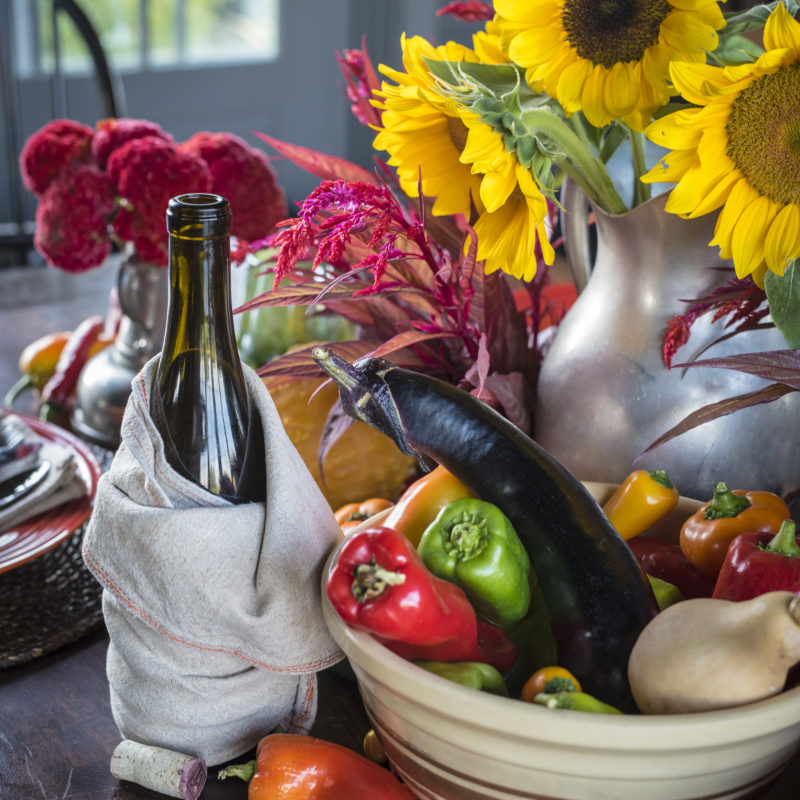By the Home Garden Seed Association
It doesn’t take much. Two 4-foot by 8-foot beds, some herb and vegetable seeds, and a couple of hours a week can put dinner on the table for a full season: fresh spring salads, sweet summer fruits, and finally, the nourishing greens and roots of autumn.
This is a sample garden plan. If you prefer turnips to beets, kaleto beans, or bush zucchini to cucumbers, make substitutions. It’s your garden! You can buy bagged compost at many garden centers, or you can make your own.Spring salads, steamed bok choy, sweet baby carrots, tender young herbs are a few of the delicious rewards of the spring garden. Tomato sandwiches, roasted peppers, chilled gazpacho, and green bean salads will fill your dinner plates from mid-summer to fall.Oats and winter rye are often used as cover crops in the north. In warmer regions, choices include mustard and bell beans. Mixes of different seeds are also available.
Step 1: The Plan
A drawing will help organize your thoughts, and your garden. Plan for the entire growing season. First come the spring greens, radishes, peas, and other cool-weather crops. In most regions, the time to plant heat-loving tomatoes, peppers, squash, and beans is just as you begin to harvest baby lettuce. Fill late season gaps with a second planting of quickgrowing greens.
Step 2: The Soil
Start right, and put some effort into creating a deep bed of rich soil. Wait until the soil has dried to the point where a fistful squeezed in your hand will crumble apart, rather than stick together in a muddy ball. Add a one-inch layer of compost, and fork the soil to a depth of at least eight inches. Your bed does not have to be perfectly smooth and even, if fact, a few small rocks can only help by improving drainage.
Site your garden in full sun, and for best results, build raised beds. Vegetables require good drainage.
Step 3: Spring into Summer
Sow greens, radishes, and peas as soon as the soil can be worked; beets and carrots shortly after. Late spring,
when night temperature consistently exceed 50°F (10°C), is the time to put tomato, pepper, and basil
plants in the ground, and sow seeds of beans, squash,
and cucumbers.
As you harvest spring vegetables, heat-loving summer plants are sizing up. This can work in your favor—head lettuces and baby greens appreciate shade cast by growing tomatoes. Some of your root vegetables can be harvested at baby size, allowing the rest room to grow.
Remember to secure trellises for cucumbers or squash and put stakes or cages around your tomatoes when plants are still small.
Varieties to Try:Touchstone Gold, Hungarian Cheese Peppers, Red Robin, and Peppermint
Step 4: Summer into Fall
Tomato plants grow quickly as the days lengthen, and take up the space left by harvested greens. Sow rows of bush beans in three-week intervals to extend their harvest time. By late summer you will be picking baskets of tomatoes, peppers, cucumbers and beans.
Starting in late summer, sprinkle lettuce seeds in the empty spaces after you harvest carrots and beets. This fall crop will provide you with salads through the fall or in some regions, even into winter.
Always replenish the soil with compost between harvesting one crop and planting another. A sprinkling of organic fertilizer will also keep your soil productive.
Step 5: End of Season Housekeeping
First, congratulate yourself for growing your own food! Then, clean up the dead tomato and pepper stalks, and put your garden to bed. Some gardeners pile chopped leaves and lawn clippings on the soil, and allow the organic cover to break down over the dormant period. You can also plant a cover crop to keep soil healthy.
Cover cropping solves the problem of leaving garden soil bare during the winter when wind and frost heaving erode topsoil and leach out nutrients. The practice creates
garden soil that is fertile with the best structure to grow healthy plants. Cover crop seeds can be purchased in garden centers, or from seed packet companies.
